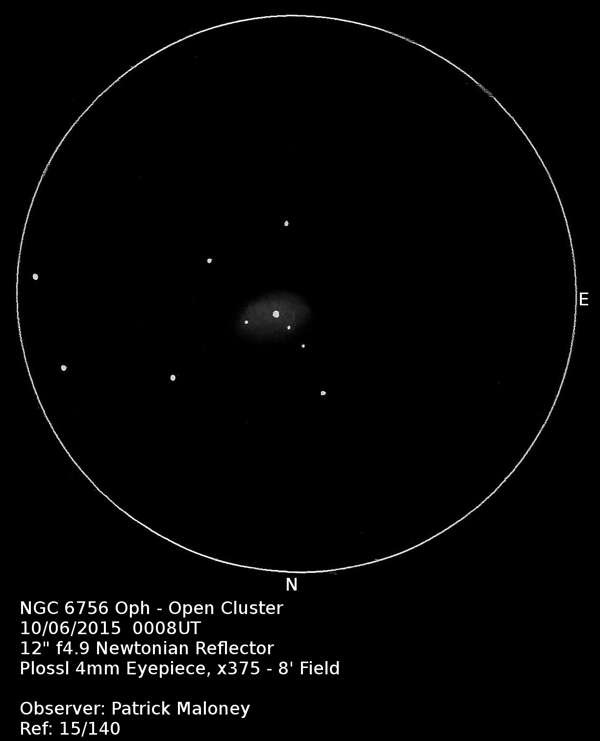NGC 6756 in Aquilia
July 2022 - Nebula and Cluster of the Month
July brings the glories of the northern Milky Way to our midnight skies. Not so great for the obsessive galaxy-hunter, though there are still plenty shining through gaps in our local galaxy’s dust. It’s a good time for open cluster enthusiasts, though.
Our open cluster for this month, although listed in the Herschel 400 observing list, is a little-known object in Aquila, NGC 6756. It was discovered by our hero William Herschel on 21 August 1791. He placed it in his class VII – ‘Pretty much compressed clusters of large or small stars’, as entry number 62. On that occasion, he described it as A pretty compressed cluster of stars not very rich
. (Phil. Trans. R. Soc. Lond. 1802 92)

William’s son John Herschel, a deep-sky observer at least as good as his father in my opinion, made four observations of the cluster which were published in his 1834 Observations of Nebulae and Clusters of Stars in which it received the designation JH 2031.
- Sweep 77:
Pretty compressed; irregular figure; 2’ diameter; stars 15th magnitude
. - Sweep 78:
Pretty compressed; Small; Round or irregular
. - Sweep 79:
Pretty compressed cluster; irregular figure
. - Sweep 278:
Pretty rich; Small; Much compressed; oval or rather fan-shaped. The stars 11..12 magnitude, 4’ in extent the north following side most compressed
.
These observations are pretty consistent with the glaring exception of the estimates of the constituent stars’ magnitudes. Somehow, they brightened from magnitude 15 to magnitude 11-12, an increase in brightness of at least 16 times!
The cluster made its way into John Herschel’s General Catalogue (GC) of 1864 as number 4471, where its description was given as Cluster; small; rich; little compressed; stars 11..12
. It has degraded from the Herschels’ description of it as ‘pretty compressed’ to ‘little compressed’, and the magnitudes have been transferred as the much brighter estimate.
When the General Catalogue was updated to the New General Catalogue in 1888, the cluster was listed as number 6756, and the GC description was retained.
What accounts for these seemingly irreconcilable differences? It depends on how you look at the object. As the photograph shows, NGC 6756 as a whole is about 4’ in diameter and generally is not very compressed. The two brightest stars in this 4’ diameter patch of sky are magnitudes 11.5 and 12.4. No other star is brighter than magnitude 13.3. These two stars are markedly different in their colour from the other stars in the cluster, though, and are therefore probably non-members lying between us and the cluster itself.
Closer inspection reveals a highly concentrated patch of stars to the northeast. Note John Herschel’s comment ...the north following side most compressed.
This area of the cluster is 1’ in diameter. This may be coincident with John Herschel’s earlier description of a cluster 2’ in diameter comprising 15th magnitude stars. The stars in this region are 14th to 16th magnitude and are very compressed.
Modern catalogues give the cluster’s diameter as 4’ and the number of stars as 40, though there are over 100 stars brighter than magnitude 16.0 within the 4’ circle. Its distance is quoted as 1507pc, or a little short of 5000 light-years. Galactic dust absorbs 1.2 magnitudes, reducing the whole object to a magnitude of 10.6. I have found different age estimates for this cluster. WEBDA gives 62 million years, a figure widely quoted. However, in a paper1 investigating the occurrence of Be stars (young, non-supergiant B-type stars that display emission lines in their spectra) in open clusters, the age of NGC 6756 (which contains two Be stars) is given as 125-150 million years. According to the authors, this would make it the oldest open cluster known to contain Be stars. In this same paper, however, NGC 7039 is quoted as having one Be star and having an age of 1000 million years. I’ll leave you to figure that out for yourself.

Visually, this object is quite striking. I observed it through my 12” Newtonian reflector in June 2015, under less than perfect skies that were also suffering from the onset of morning twilight. I noted a bean-shaped curve of nebulous, unresolved stars. Some member stars were seen superimposed. These stars range from magnitude 14.2 to 14.5, about my limit for the brightening sky. The background of unresolved stars is quite bright and looks very much like a low-power view of a globular cluster.
It’s a cracking little object.
| Object | RA | Dec | Type | Magnitude |
|---|---|---|---|---|
| NGC 6756 | 19h 08’ 44” | +04° 42’ 51” | Open cluster | 10.6 |
Reference
- Be phenomenon in open clusters: results from a survey of emission-line stars in young open clusters. Blesson Mathew, Annapurni Subramaniam and Bhuwan Chandra Bhatt. Mon. Not. R. Astron. Soc. 388, 1879–1888 (2008)